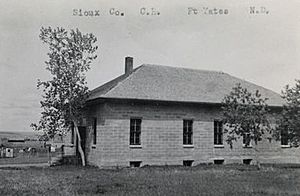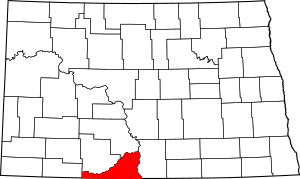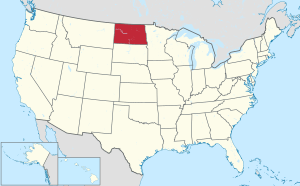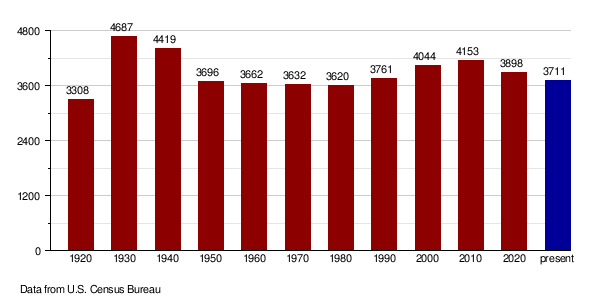Sioux County, North Dakota facts for kids
Quick facts for kids
Sioux County
|
|
|---|---|

Postcard. Historic Sioux County Courthouse at Fort Yates, North Dakota.
|
|

Location within the U.S. state of North Dakota
|
|
 North Dakota's location within the U.S. |
|
| Country | |
| State | |
| Founded | September 3, 1914 (created) September 12, 1914 (organized) |
| Named for | Sioux people |
| Seat | Fort Yates |
| Largest community | Cannon Ball |
| Area | |
| • Total | 1,128 sq mi (2,920 km2) |
| • Land | 1,094 sq mi (2,830 km2) |
| • Water | 34 sq mi (90 km2) 3.0% |
| Population
(2020)
|
|
| • Total | 3,898 |
| • Estimate
(2022)
|
3,711 |
| • Density | 3.4557/sq mi (1.3342/km2) |
| Time zones | |
| (eastern portion) | UTC−6 (Central) |
| • Summer (DST) | UTC−5 (CDT) |
| (western portion) | UTC−7 (Mountain) |
| • Summer (DST) | UTC−6 (MDT) |
| Congressional district | At-large |
Sioux County is a county located along the southern border of the U.S. state of North Dakota. As of the 2020 census, the population was 3,898. Its eastern border is the Missouri River and its county seat is Fort Yates.
Contents
History
The county was created by proclamation of Governor Louis B. Hanna on September 3, 1914. It was named for the Native American Lakota, whose historic territory included this area. The county government organization was completed on September 12 of that year. The county lies entirely within the Standing Rock Indian Reservation, forming the northernmost 30 percent of the reservation; the balance of the reservation is in South Dakota. It is the only county in North Dakota that is entirely within an Indian reservation. From 2013 to 2018, Sioux County was included in the Bismarck, ND Metropolitan Statistical Area.
Geography
Sioux County lies on the south line of North Dakota. Its south boundary line abuts the north boundary line of the state of South Dakota. Its north boundary line is formed by the east-northeastward-flowing Cedar Creek, which discharges into the Missouri River at the county's northeast corner, and its east boundary line is formed by the south-southeast-flowing Missouri River, which also forms Lake Oahe along the county boundary line. Porcupine Creek flows southeastward into the Missouri River, draining the northeastern part of the county. The county terrain consists of low rolling hills etched with gullies and drainages; the area is mostly devoted to agriculture. The terrain slopes to the east and south; its highest point is on the west line, near the southwestern corner of the county, at 2,602 ft (793 m) ASL. The county has a total area of 1,128 square miles (2,920 km2), of which 1,094 square miles (2,830 km2) is land and 34 square miles (88 km2) (3.0%) is water.
The southwest corner counties of North Dakota (Adams, Billings, Bowman, Golden Valley, Grant, Hettinger, Slope, and Stark) observe Mountain Time. The counties of McKenzie, Dunn, and Sioux are split, observing Mountain Time in their western portions.
Major highways
Adjacent counties
- Morton County - north (observes Central Time)
- Emmons County - east (observes Central Time)
- Corson County, South Dakota - south (observes Mountain Time)
- Adams County - west (observes Mountain Time)
- Grant County - northwest (observes Mountain Time)
Protected areas
- Cedar River National Grassland (part)
- Froelich Dam State Game Management Area
Demographics
| Historical population | |||
|---|---|---|---|
| Census | Pop. | %± | |
| 1920 | 3,308 | — | |
| 1930 | 4,687 | 41.7% | |
| 1940 | 4,419 | −5.7% | |
| 1950 | 3,696 | −16.4% | |
| 1960 | 3,662 | −0.9% | |
| 1970 | 3,632 | −0.8% | |
| 1980 | 3,620 | −0.3% | |
| 1990 | 3,761 | 3.9% | |
| 2000 | 4,044 | 7.5% | |
| 2010 | 4,153 | 2.7% | |
| 2020 | 3,898 | −6.1% | |
| 2022 (est.) | 3,711 | −10.6% | |
| U.S. Decennial Census 1790-1960 1900-1990 1990-2000 2010-2020 |
|||
2020 census
As of the census of 2020, there were 3,898 people.
2010 census
As of the census of 2010, there were 4,153 people, 1,158 households, and 900 families in the county. The population density was 3.8 inhabitants per square mile (1.5/km2). There were 1,311 housing units at an average density of 1.2 per square mile (0.46/km2). The racial makeup of the county was 84.1% American Indian, 12.6% white, 0.2% black or African American, 0.1% Asian, 0.1% from other races, and 2.9% from two or more races. Those of Hispanic or Latino origin made up 2.0% of the population. In terms of ancestry, 13.5% were German, and 0.3% were American.
Of the 1,158 households, 54.1% had children under the age of 18 living with them, 32.5% were married couples living together, 31.6% had a female householder with no husband present, 22.3% were non-families, and 17.4% of all households were made up of individuals. The average household size was 3.55 and the average family size was 3.89. The median age was 26.3 years.
The median income for a household in the county was $30,990 and the median income for a family was $31,098. Males had a median income of $31,894 versus $26,619 for females. The per capita income for the county was $13,542. About 39.0% of families and 47.2% of the population were below the poverty line, including 58.4% of those under age 18 and 36.1% of those age 65 or over.
Population by decade

Communities
Cities
- Fort Yates (county seat)
- Selfridge
- Solen
Census-designated places
Township
- Menz
Education
School districts include:
- Fort Yates Public School District 4 (in cooperation with the Standing Rock Bureau of Indian Education (BIE) grant school)
- Selfridge Public School District 8
- Solen Public School District 3
See also
 In Spanish: Condado de Sioux (Dakota del Norte) para niños
In Spanish: Condado de Sioux (Dakota del Norte) para niños

